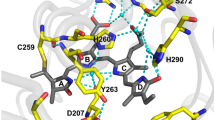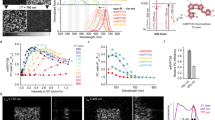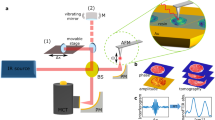Abstract
We have developed an imaging spectrophotometer that combines the spatial-resolving properties of a video camera with the wavelength-resolving properties of a spectrophotometer. This instrument is especially useful for screening photosynthetic bacteria, since hundreds of colonies may be analyzed simultaneously through the chromophoric properties of the photosynthetic pigments. Enhanced fluorescence mutants (possessing defective photosynthetic reaction centers) can be imaged in realtime using a silicon target camera. Mutant screening is further facilitated through imaging spectroscopy, wherein images obtained at specific wavelengths are mixed to generate pseudo images of the colonies. Digital image processing techniques can then be used to highlight distinguishing spectroscopic features of the colonies. Future applications of imaging spectroscopy to other areas of molecular biology are discussed.
This is a preview of subscription content, access via your institution
Access options
Subscribe to this journal
Receive 12 print issues and online access
$209.00 per year
only $17.42 per issue
Buy this article
- Purchase on Springer Link
- Instant access to full article PDF
Prices may be subject to local taxes which are calculated during checkout
Similar content being viewed by others
References
Lillesand, T.M. and Kiefer, R.W. 1987. Remote Sensing and Image Interpretation. John Wiley & Sons, New York, NY.
National Aeronautics and Space Administration. 1987. HIRIS—High-Resolution Imaging Spectrometer: Science Opportunities for the 1990s: Earth Observing System. Volume IIc.
Fabry, C. and Perot, A. 1899. Theorie et applications d'une nouvelle methode de spectroscopie interferentielle. Ann. Chim. Phys., Paris 7th series 16:115–144.
Macleod, H.A. 1986. Thin-Film Optical Filters. Macmillan Publishing Company, New York, NY.
Youvan, D.C. and Marrs, B.L. 1984. Molecular genetics and the light reactions of photosynthesis. Cell. 39:1–3.
Youvan, D.C. and Marrs, B.L. 1987. Molecular mechanisms of photosynthesis. Scientific American. June:42–48.
Youvan, D.C., Hearst, J.E. and Marrs, B.L. 1983. Isolation and characterization of enhanced fluorescence mutants of Rhodopseudomonas capsulata. J. Bacteriol. 154:748–755.
Youvan, D.C. and Bylina, E.J. 1988. Photosynthesis in Rhodospmllaceae. In: Genetics of Bacterial Diversity. Hopwood, D. A. and Chater, K. F., (Eds. ). Academic Press, New York, NY. In press.
Scolnik, P.A., Walker, M.A. and Marrs, B.L. 1980. Biosynthesis of carotenoids derived from neurosporene in Rhodopseudomonas capsulata. J. Biol. Chem. 155:2427–2432.
Youvan, D.C., Ismail, S. and Bylina, E.J. 1985. Chromosomal deletion and plasmid complementation of the photosynthetic reaction center and light-harvesting genes from Rhodopseudomonas capsulata. Gene 38:19–30.
Bylina, E.J., Ismail, S. and Youvan, D.C. 1986. Site-specific mutagen-esis of bacteriochlorophyll-binding sites affects biogenesis of the photosynthetic apparatus. In: Microbial Energy Transduction: Genetics, Structure, and Function of Membrane Proteins. Youvan, D. C. and Daldal, F.(Ed.). Cold Spring Harbor Laboratory, Cold Spring Harbor, NY.
Bylina, E.J. and Youvan, D.C. 1987. Genetic engineering of herbicide resistance: Saturation mutagenesis of isoleucine 229 of the reaction center L subunit. Z. Naturforsch. 42c:769–774.
Bylina, E.J. and Youvan, D.C. 1988. Directed mutations affecting spectroscopie and electron transfer properties of the primary donor in the photosynthetic reaction center. Proc. Natl. Acad. Sci. USA. In Press.
Davidson, E., Prince, R.C., Daldal, F., Hauska, G. and Marrs, B.L. 1987. Rhodobacter capsulatus MT113: A single mutation results in the absence of c-type cytochromes and in the absence of the cytochrome bc1 complex. Biochem. Biophys. Acta. 890:292–301.
Zuber, H. 1986. Structure of light-harvesting antenna complexes of photosynthetic bacteria, cyanobacteria and red algae. TIBS 4:414–419.
Yang, M. and Youvan, D.C. Application of imaging spectroscopy in molecular biology. II. Enhancing gel electrophoresis bands with kernels and visualizing fluorescent dideoxy-terminators. In preparation.
Prober, J.M., Trainor, G.L., Dam, R.J., Hobbs, F.W., Robertson, C.W., Zagursky, R.J., Cocuzza, A.J., Jensen, M.A. and Baumeister, K. 1987. A system for rapid DNA sequencing with fluorescent chain-terminating dideoxynucleotides. Science. 238:336–341.
Yen, H-C. and Marrs, B. 1977. Growth of Rhodopseudomonas capsulata under anaerobic dark conditions with dimethyl sulfoxide. Arch. Biochem. and Biophys. 181:411–418.
Gonzalez, R.C. and Wintz, P. 1987. Digital Image Processing. Addison-Wesley Publishing Co., Inc., Reading, MA.
Author information
Authors and Affiliations
Rights and permissions
About this article
Cite this article
Yang, M., Youvan, D. Applications of Imaging Spectroscopy in Molecular Biology: I. Screening Photosynthetic Bacteria. Nat Biotechnol 6, 939–942 (1988). https://doi.org/10.1038/nbt0888-939
Received:
Accepted:
Issue Date:
DOI: https://doi.org/10.1038/nbt0888-939
This article is cited by
-
Altered phosphorylation state of branched‐chain 2‐Oxo acid dehydrogenase in a branched‐chain acyltransferase deficient human fibroblast cell line
Journal of Inherited Metabolic Disease (1991)



